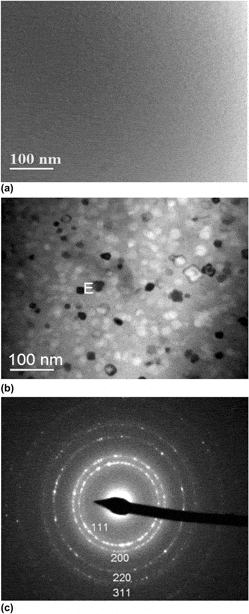Crossref Citations
This article has been cited by the following publications. This list is generated based on data provided by
Crossref.
Huang, Hu
and
Yan, Jiwang
2015.
On the surface characteristics of a Zr-based bulk metallic glass processed by microelectrical discharge machining.
Applied Surface Science,
Vol. 355,
Issue. ,
p.
1306.
Huang, Tyau-Song
Hsieh, Shy-Feng
Chen, Sung-Long
Lin, Ming-Hong
Ou, Shih-Fu
and
Chang, Wei-Tse
2015.
The effect of acetylene as a dielectric on modification of TiNi-based shape memory alloys by dry EDM.
Journal of Materials Research,
Vol. 30,
Issue. 22,
p.
3484.
Chen, Wen
Ketkaew, Jittisa
Liu, Ze
Mota, Rodrigo Miguel Ojeda
O’Brien, Kevin
da Silva, Caio Sene
and
Schroers, Jan
2015.
Does the fracture toughness of bulk metallic glasses scatter?.
Scripta Materialia,
Vol. 107,
Issue. ,
p.
1.
Huang, Hu
and
Yan, Jiwang
2016.
Microstructural changes of Zr-based metallic glass during micro-electrical discharge machining and grinding by a sintered diamond tool.
Journal of Alloys and Compounds,
Vol. 688,
Issue. ,
p.
14.
Axinte, Eugen
Bofu, Andrei
Wang, Yan
Abdul-Rani, Ahmad Majdi
Aliyu, Abdul Azeez Abdu
Slătineanu, L.
Nagit, G.
Dodun, O.
Merticaru, V.
Coteata, M.
Ripanu, M.I.
Mihalache, A.M.
Boca, M.
Ibanescu, R.
Panait, C.E.
Oancea, G.
and
Kyratsis, P.
2017.
An overview on the conventional and nonconventional methods for manufacturing the metallic glasses.
MATEC Web of Conferences,
Vol. 112,
Issue. ,
p.
03003.
Chen, Wen
Zhou, Haofei
Liu, Ze
Ketkaew, Jittisa
Shao, Ling
Li, Ning
Gong, Pan
Samela, William
Gao, Huajian
and
Schroers, Jan
2018.
Test sample geometry for fracture toughness measurements of bulk metallic glasses.
Acta Materialia,
Vol. 145,
Issue. ,
p.
477.
Liu, Chong
Duong, Nick
Jahan, Muhammad P.
Ma, Jianfeng
and
Kirwin, Roan
2019.
Experimental investigation and numerical simulation of micro-EDM of bulk metallic glass with focus on crater sizes.
Procedia Manufacturing,
Vol. 34,
Issue. ,
p.
275.
Kuriakose, Sandeep
Patowari, Promod Kumar
and
Bhatt, Jatin
2019.
Effect of micro-EDM machining parameters on the accuracy of micro hole drilling in Zr-based metallic glass.
Engineering Research Express,
Vol. 2,
Issue. 1,
p.
015001.
Zhang, Lin
and
Huang, Hu
2019.
Micro machining of bulk metallic glasses: a review.
The International Journal of Advanced Manufacturing Technology,
Vol. 100,
Issue. 1-4,
p.
637.
Xu, Jinkai
Pei, Qiangqiang
Lian, Zhongxu
Yu, Peng
Ma, Guangsheng
and
Yu, Huadong
2019.
Experimental study on wire-electrical discharge machining of zirconium-based metallic glass.
Materials Research Express,
Vol. 6,
Issue. 11,
p.
115214.
Ma, Zhichao
Lu, Fangzhou
Ma, Xiaoxi
Zhao, Hongwei
Zeng, Kaiyang
and
Ren, Luquan
2020.
Cyclic stress induced surface nanocrystallization adjacent to indentation edge of Zr-based bulk metallic glass at room temperature.
Applied Surface Science,
Vol. 506,
Issue. ,
p.
145044.
Li, Z.
and
Ma, J.
2021.
Water-repellent surfaces of metallic glasses: fabrication and application.
Materials Today Advances,
Vol. 12,
Issue. ,
p.
100164.
Guo, Cheng
Wu, Bo
Bin Xu
Wu, Shiyun
Shen, Jun
and
Wu, Xiaoyu
2021.
Investigation of Pulse Electrochemical Machining of Zr-Based Bulk Metallic Glasses in NaNO3-Ethylene Glycol Electrolyte.
Journal of The Electrochemical Society,
Vol. 168,
Issue. 7,
p.
071502.
Chen, Shunhua
Gu, Hewei
Feng, Kangkang
Zheng, Hongmei
and
Chen, Ke
2022.
A comparative study on the die-sinking EDM performance of bulk metallic glass composites under rough and refined conditions.
The International Journal of Advanced Manufacturing Technology,
Vol. 121,
Issue. 7-8,
p.
4865.
Du, Jinguang
Tian, Biao
Duan, Liuyang
Ming, Wuyi
Liu, Kun
and
He, Wenbin
2022.
Traditional and non-traditional machining technology of metallic glass.
The International Journal of Advanced Manufacturing Technology,
Vol. 120,
Issue. 5-6,
p.
2879.
Chang, Weijie
Li, Xiangxiang
Yang, Haidong
Zhang, Junsheng
Zhang, Juchen
Tang, Huohong
and
Chen, Shunhua
2022.
On the wire EDM of metastable atomic structured bulk metallic glasses.
The International Journal of Advanced Manufacturing Technology,
Vol. 120,
Issue. 7-8,
p.
5411.
Guo, Cheng
He, Jingwen
Zhuang, Weizhen
Li, Kangsen
and
Li, Duo
2023.
Fabrication of Dimples by Jet-ECM of Zr-Based Bulk Metallic Glasses with NaCl-Ethylene Glycol Electrolyte.
Micromachines,
Vol. 14,
Issue. 12,
p.
2196.
Hang, Wei
Song, Chao
Yin, Ziliang
Liu, Ye
Wang, Qifan
Wang, Yinggang
Ma, Yi
and
Zeng, Qiaoshi
2023.
Research on Chemical Mechanical Polishing Technology for Zirconium-Based Amorphous Alloys.
Micromachines,
Vol. 14,
Issue. 3,
p.
584.
Graeve, Olivia A.
García-Vázquez, Mireya S.
Ramírez-Acosta, Alejandro A.
and
Cadieux, Zachary
2023.
Latest Advances in Manufacturing and Machine Learning of Bulk Metallic Glasses.
Advanced Engineering Materials,
Vol. 25,
Issue. 9,
Chen, Shunhua
Gu, Hewei
Wang, Jingyuan
Chang, Weijie
and
Chan, Kangcheung
2023.
Processing of monolithic bulk metallic glass using sinking electrical discharge machining.
The International Journal of Advanced Manufacturing Technology,
Vol. 126,
Issue. 11-12,
p.
5057.
